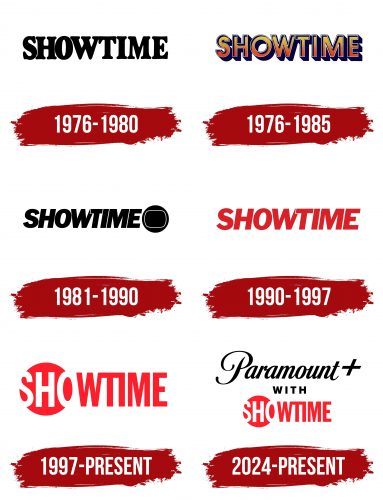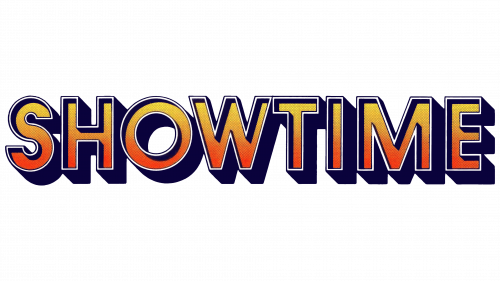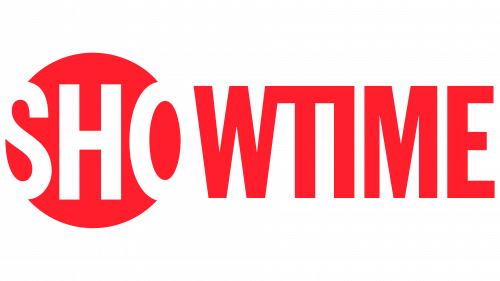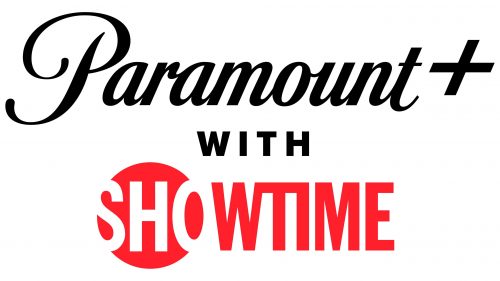The Showtime logo symbolizes partnership and the brand’s dual enjoyment to its premium subscribers. The emblem promises unlimited access to favorite shows and series, offering unique, exclusive film premieres created with the network’s direct involvement and support. Every detail of the logo emphasizes exclusivity, showcasing the privileges for those who choose this content, which combines quality and access to the best entertainment programs without limitations.
Showtime: Brand overview
The history of Showtime began in 1976 when Viacom launched it as a regional premium cable service in California. Initially, the channel featured sporting events, specials, and movies, attracting viewers with its ad-free, wide-ranging content.
In 1978, the service began expanding nationally and gradually became available nationwide. This expansion was accompanied by increased investment in original programming, helping it compete with other premium services like HBO.
A major milestone occurred in 1982 with the debut of the first original movie, The Ratings Game. This marked the start of the network’s commitment to original content, which would become a key feature of its brand.
In 1983, Viacom sold a share of the channel to Warner Communications (now WarnerMedia), leading to the creation of Showtime/The Movie Channel, Inc. This partnership allowed the network to grow its audience and expand its film library.
In 1986, the company launched its first original series, Brothers, which not only pioneered LGBTQ representation on TV but also set the stage for its bold future.
In 1990, Viacom regained full control of Showtime/The Movie Channel, Inc. by purchasing Warner’s stake, allowing for increased investment in original programming.
The 1990s saw the release of Life with Louie, which won the company its first Emmy Award for Outstanding Animated Series in 1992.
The channel continued to increase its output of original shows in the late 1990s and early 2000s, including Queer as Folk (2000-2005) and The L Word (2004-2009). These groundbreaking shows drew new audiences and solidified the brand’s reputation for tackling challenging and controversial topics.
In 2006, a breakthrough came with the debut of Dexter, a critically acclaimed show about a forensic scientist who is secretly a serial killer. Dexter became one of the network’s most popular and celebrated series.
In 2007, the company launched its streaming service, Showtime Anytime, allowing subscribers to watch content online, a vital adaptation to changing viewer habits.
Another hit, Shameless, debuted in 2009 and became one of the longest-running series, concluding in 2021 after 11 successful seasons.
Throughout the 2010s, the network continued producing hit shows like Homeland (2011-2020), Ray Donovan (2013-2020), and Billions (2016-present). This series earned critical acclaim and numerous awards.
In 2015, a major move was made by launching a stand-alone streaming service, allowing viewers to subscribe without a cable package, further expanding the audience.
The 2019 merger of Viacom and CBS Corporation to form ViacomCBS (now Paramount Global) brought new corporate opportunities for collaboration across various brands.
Despite global challenges, the company maintained its quality content production in 2020 and 2021, with notable releases like Bryan Cranston’s Your Honor and The Good Fight miniseries.
In 2022, further integration with the Paramount+ streaming platform enhanced the network’s reach and adapted to the competitive streaming market.
As of 2023, this premium service remains one of the leading cable and streaming platforms in the U.S., continuing to invest in original programming and known for its bold, innovative television. With over 50 years in operation, the network has transformed from a small regional service into a prominent global entertainment brand, constantly evolving to meet the demands of modern media consumption.
Meaning and History
What is Showtime?
This cable and streaming network has carved out a unique place in the entertainment industry with its bold content. Known for its diverse lineup of original shows, films, documentaries, and sports broadcasts, the network has gained fame for not shying away from controversial topics and complex storylines. It has earned recognition for supporting new talent and creating programs aimed at adult audiences that often become the center of cultural discussions. The network’s original programming includes political thrillers, reality shows with edgy plots, dark comedies, and gritty dramas. Its ability to produce thoughtful and daring content has made the network a key player in the media industry, with its shows in high demand among viewers and critics.
1976 – 1980
The first emblem of the Times-Mirror cable network appears both simple and meaningful. It reflects a company’s confidence that did not start from scratch but as a continuation of Channel One, gaining 10,000 subscribers from the outset. The black lettering is executed in tall, capitalized letters with fine serifs, emphasizing the network’s drive for growth and development and its focus on showcasing significant and popular shows. The serifs add an element of individuality, setting the channel apart from others. Thanks to this unique approach, the subscriber base grew fivefold in the first year, confirming the program’s success.
1976 – 1985
The channel launch on the Viacom network took place a week after Times-Mirror, and the brand received a brighter and more memorable design. The capital letters of the logo, executed with a three-dimensional effect in a rich yellow-orange gradient, created the atmosphere of a stage and a show. This design perfectly matched the program’s theme, particularly popular artists’ performances. The silver border gave the logo a shine and a chic touch, enhancing the feeling of celebration and exclusivity. The design directly resonated with one of the key shows of the program — Celebration, which emphasized the central place of entertainment projects on the air.
1981 – 1990
The logo acquired a more dynamic look with the transition to 24-hour broadcasting and a significant increase in the number of programs. The capital letters are in italics, symbolizing movement and growth. A black schematic television on the right complements the image, visually emphasizing its connection to broadcast television. The logo’s color palette plays on the night’s theme, highlighting the channel’s round-the-clock operation. The slanted font also reflects rapid development and the constant pace of broadcasting, which continues without interruption, creating a sense of activity and unchanging energy.
1990 – 1997
When the channel began broadcasting premieres of independent films, its logo also changed, and the font became bright red. This rich shade emphasized the solemnity and significance of the first showings, enhancing the impact of debut screenings. The red color added drama to the logo and highlighted the ambition of the projects, many of which were so successful that they were even nominated for an Oscar. Removing the television image from the emblem symbolized an important moment in the company’s history — its renaming to Showtime Networks, Inc., reflecting a new level of independence and expansion.
1997 – today
The updated logo emphasized the abbreviation “SHO,” which was actively used in promotional materials and served as the channel’s identifier. This element was placed inside a bright red sphere, symbolizing Showtime’s exciting and dynamic world. The red color and contrasting white letters highlight the premium status of the service, offering viewers the freedom of choice and the ability to create their program without censorship or limitations.
A Showtime subscription feels like a real gift, as the channel carefully considers its audience’s interests and preferences. The remaining part of the name is in an elongated red font, giving the emblem a sense of aspiration and growth. This design approach emphasizes the brand’s ambitions, readiness for constant development, and drive for leadership.
2024 – today
The logo uniting Paramount+ and Showtime symbolizes the merger of two powerful brands within Paramount Global’s streaming platform. This move reflects the company’s strategy of consolidating content to attract a wide audience.
The first element of the emblem is the “Paramount+” inscription in a classic font with characteristic smooth lines and the emphasized “+” symbol. The font is rooted in the history of the Paramount brand, which has always been associated with high quality and the prestige of Hollywood cinema. The elegant black visual mark symbolizes the studio’s stability, reliability, and long-standing success.
The second element is the Showtime name, executed in bold, bright red. The name has always been associated with the emotion, tension, and drama characteristic of the channel’s programs. The bold, straightforward letters of the Showtime logo seem to declare the courage and strength of the content offered to viewers.
Between the two major brands is the neutral word “with,” written in a simple black font. It serves as a connecting element, smoothly blending Paramount’s elegance with Showtime’s energy and audacity.
This emblem represents a new era in the brand’s history as streaming platforms become integral to the entertainment industry. The unification of two powerful brands in one visual solution reflects the company’s ambition to become a leader in the streaming market, offering viewers a diverse range of content and a high standard of quality.










